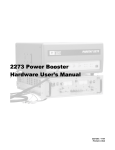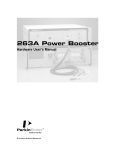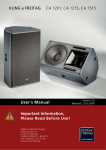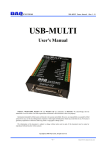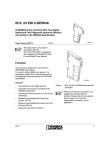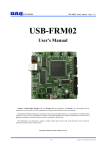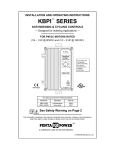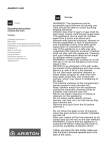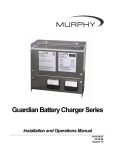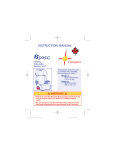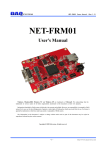Download 273A Power Booster Manual - Princeton Applied Research
Transcript
0RGHO$3RZHU%RRVWHU 8VHU·V 0DQXDO 223052 B / 0602 Printed in USA $GYDQFHG 0HDVXUHPHQW 7HFKQRORJ\ ,QF a/k/a Princeton Applied Research, a subsidiary of AMETEK®, Inc. :$55$17< Princeton Applied Research* warrants each instrument of its own manufacture to be free of defects in material and workmanship. Obligations under this Warranty shall be limited to replacing, repairing or giving credit for the purchase price, at our option, of any instrument returned, shipment prepaid, to our Service Department for that purpose within ONE year of delivery to the original purchaser, provided prior authorization for such return has been given by an authorized representative of Princeton Applied Research. This Warranty shall not apply to any instrument, which our inspection shall disclose to our satisfaction, to have become defective or unworkable due to abuse, mishandling, misuse, accident, alteration, negligence, improper installation, or other causes beyond our control. This Warranty shall not apply to any instrument or component not manufactured by Princeton Applied Research. When products manufactured by others are included in Princeton Applied Research equipment, the original manufacturer's warranty is extended to Princeton Applied Research customers. Princeton Applied Research reserves the right to make changes in design at any time without incurring any obligation to install same on units previously purchased. THERE ARE NO WARRANTIES THAT EXTEND BEYOND THE DESCRIPTION ON THE FACE HEREOF. THIS WARRANTY IS IN LIEU OF, AND EXCLUDES ANY AND ALL OTHER WARRANTIES OR REPRESENTATIONS, EXPRESSED, IMPLIED OR STATUTORY, INCLUDING MERCHANTABILITY AND FITNESS, AS WELL AS ANY AND ALL OTHER OBLIGATIONS OR LIABILITIES OF PRINCETON APPLIED RESEARCH, INCLUDING, BUT NOT LIMITED TO, SPECIAL OR CONSEQUENTIAL DAMAGES. NO PERSON, FIRM OR CORPORATION IS AUTHORIZED TO ASSUME FOR PRINCETON APPLIED RESEARCH ANY ADDITIONAL OBLIGATION OR LIABILITY NOT EXPRESSLY PROVIDED FOR HEREIN EXCEPT IN WRITING DULY EXECUTED BY AN OFFICER OF PRINCETON APPLIED RESEARCH. 6+28/' <285 (48,30(17 5(48,5( 6(59,&( A. Contact the Customer Service Department (865-482-4411) or your local representative to discuss the problem. In many cases it will be possible to expedite servicing by localizing the problem. B. If it is necessary to send any equipment back for service, we need the following information. 1. Model number and serial number. 5. Your telephone number and extension. 2. Your name (instrument user). 6. Symptoms (in detail, including control settings). 3. Your address. 7. Your purchase order number for repair charges (does not apply to repairs in warranty). 4. Address to which the instrument should be returned. 8. Shipping instructions (if you wish to authorize shipment by any method other than normal surface transportation). C. U.S. CUSTOMERS — Ship the equipment being returned to: Advanced Measurement Technology, Inc. 801 S. Illinois Avenue Oak Ridge, TN 37831 ATTN: Customer Service PHONE: 865-482-4411 FAX: 865-483-2133 D. CUSTOMERS OUTSIDE OF U.S.A. — To avoid delay in customs clearance of equipment being returned, please contact the factory or the nearest factory distributor for complete shipping information. Copyright © 2002, Advanced Measurement Technology, Inc. All rights reserved. *Princeton Applied Research is a registered trademark of Advanced Measurement Technology, Inc. All other trademarks used herein are the property of their respective owners. ii 7$%/(2)&217(176 1. GENERAL . . . . . . . . . . . . . . . . . . . . . . . . . . . . . . . . . . . . . . . . . . . . . . . . . . . . . . . . . . . . . . . . . . . 1 2. SYSTEM SPECIFICATIONS . . . . . . . . . . . . . . . . . . . . . . . . . . . . . . . . . . . . . . . . . . . . . . . . . . . . . 3 3. INTERCONNECTIONS AND FRONT-PANEL SETUP . . . . . . . . . . . . . . . . . . . . . . . . . . . . . . . . . 5 3.1. Connecting the Potentiostat to the Power Booster Interface . . . . . . . . . . . . . . . . . . . . . . . . . 5 3.2. Connecting the KEPCO to the Power Booster Interface . . . . . . . . . . . . . . . . . . . . . . . . . . . . 6 3.3. Power Booster Interface Front-Panel Setup . . . . . . . . . . . . . . . . . . . . . . . . . . . . . . . . . . . . . 6 3.4. KEPCO Front-Panel Setup . . . . . . . . . . . . . . . . . . . . . . . . . . . . . . . . . . . . . . . . . . . . . . . . . . 7 3.5. External Cell Connection and Initial Check . . . . . . . . . . . . . . . . . . . . . . . . . . . . . . . . . . . . . . 7 iii iv Model 273A Power Booster User’s Manual *(1(5$/ The Model 273A Power Booster is designed for special electrochemical applications such as battery research, pulse plating, and etching. Three models are available: The 273A/10A provides 0±10 amps (nominal1)at 0±20 volts compliance The 273A/20A provides 0±20 amps (nominal) at 0±20 volts compliance The 273A/8A provides 0±8 amps (nominal) at 0±50 volts compliance This add-on system consists of a specially configured 20-10A, 20-20A, or 50-8A bipolar power supply from KEPCO®, Inc., and a Princeton Applied Research Power Booster Interface (see the block diagram in Fig. 1). The Power Booster interfaces the 273A and the external cell, acts as the cell switch, and provides the drive signal for the KEPCO power supply. Experiments can be controlled manually from the front panel of the 273A or from a PC using the appropriate Princeton Applied Research software. The Power Booster Interface also provides cell current (scaled) required by the 273A I/E converter. With the 273A current range set to 10 uA, 1 µA reading on 273A = 1 A actual cell current; and 10 µA reading on 273A = 10 A actual cell current. The system frequency response has been modified to provide stability for the complete closed-loop response for electrochemical cells with a very high capacitance and very low resistance. The Power Booster Interface is available for 273 or 273A potentiostats (for simplicity, the manual only refers to the 273A). It operates in power-boosted or normal mode — a simple cable connection converts between modes. This manual discusses boosted mode only. For normal operation, see the potentiostat's user manual. Connections and settings are identical among the three Power Booster Interface options. However, for simplicity, we discuss and illustrate only the 10-A unit in this manual. CAUTION 1 Do not use auto-ranging current in Power Booster mode! The 273A should be set to the 10-µA current range on the front panel or via PC/software control. Determined by the KEPCO. 1 Fig. 1. Block Diagram for the 273A Power Booster System. 2 Model 273A Power Booster User’s Manual 6<67(063(&,),&$7,216 Bandwidth >5 KHz at 3 db with 1 V applied at counter with 1- cell (1-W load). Voltage Rise Time <70 µs (10–90%, measured at counter, ± 10 V/100-Hz square wave into a 1-W load, high-speed mode). Potential Noise <500 µ V rms at E Monitor Out. Applied Potential Accuracy ±0.5% of reading, ±2 mV. Current Measurement Rise Time <75 µs (10–90%, measured at I Monitor Out, ±10 A/100-Hz square wave). Current Measurement Accuracy ±1% of reading, ±20 mA. Rated Output Current 20 A (nominal) for the 273A/20A system; 10 A (nominal) for the 273A/10A system; and 8 A (nominal) for the 273A/8A system. Rated Output Voltage 20 V at 20 A (nominal) for the 273A/20A and 273A/10A; 50 V at 8 A (nominal) for the 273A/8A. Overload Shutdown ±20 V or ±20 A (nominal) for the 273A/20A; ±20 V or ±10 A (nominal) for the 273A/10A; and ±50 V or ±8 A (nominal) for the 273A/8A.2 2 The KEPCO power supply allows you to limit the overload shutdown (that is, to create shutdown set points at lower than the maximum value. Refer to the KEPCO manual for more information.) 3 4 Model 273A Power Booster User’s Manual ,17(5&211(&7,216$1')52173$1(/ 6(783 3.1. Connecting the Potentiostat to the Power Booster Interface The 273A and Power Booster Interface are connected by 3 marked cables provided with the interface unit (see also the diagram in Fig. 2). NOTE Do not use the C0342 cable (the label is on a white tab) in power-boosted mode. C0342 is for normal operation only (for instructions on using it, see the 273A User’s Guide). Fig. 2. Connecting the 273A, KEPCO Power Supply, and Power Booster Interface. REMOTE CELL ENABLE Cable Connect the 273A’s rear-panel REMOTE CELL ENABLE BNC connector to the rear panel of the Power Booster Interface at the BNC connector marked C. 5 POWER AMP MONITOR Cable Connect the 273A’s rear-panel POWER AMP MONITOR BNC connector to the rear panel of the Power Booster Interface at the BNC connector marked F. 273 INTERFACE Cable Connect the 273A’s rear-panel CELL INTERFACE connector (37-pin D) to the rear panel of the Power Booster Interface at the 37-pin D-connector labeled 273A INTERFACE CABLE. 3.2. Connecting the KEPCO to the Power Booster Interface S-COM Connection Connect the S-COM brown wire to S COM (or COM; they are shorted together) on the KEPCO rear panel. Connect the opposite end of the wire to screw-clamp connector 3 on the rear panel of the Power Booster Interface. S-OUT Connection Connect the S-OUT red wire to S OUT on the KEPCO rear panel. Connect the opposite end of the wire to screw-clamp connector 1 on the rear panel of the Power Booster Interface. Cardedge/Double BNC Cable Connect the cardedge (female) connector to the card edge (male) projecting from the KEPCO rear panel (both connectors are keyed to ensure correct orientation). On the double-BNC end of the cable, connect the E/IN connector to the rear panel of the Power Booster Interface at the BNC connector marked E. Connect the I/OUT BNC portion of the cable to the rear panel of the Power Booster Interface at the BNC connector marked D. 3.3. Power Booster Interface Front-Panel Setup 273A ELECTROMETER Cable Connect the 25-pin, male D-connector to the 273A Differential Electrometer. The opposite end of the cable, labeled CHASSIS FRONT PANEL, should be connected the front panel of the Power Booster Interface at the 37-pin D-connector labeled 273A ELECTROMETER CABLE. Keyed, 9-Pin Connector Cable Connect the 9-pin keyed connector to the front panel of the Power Booster Interface at the COUNTER/WORKING connection. This cable has the red and green springclamp connectors at the opposite end. 6 Model 273A Power Booster User’s Manual 3.4. KEPCO Front-Panel Setup The MODE switch on the front panel of the KEPCO should be set to Voltage mode (left position). The Voltage CONTROL switch (red toggle on left side) should be in the OFF (down) position. The Current CONTROL switch (red toggle on right side) should be in the OFF (down) position. The SENSE/COMMON (black banana jacks at bottom-center) should be connected with a shorting bracket. The OUTPUT/SENSE (red banana jacks at bottom-center) should be connected with a shorting bracket. 3.5. External Cell Connection and Initial Check Use the provided cell cable to connect the electrochemical cell under test to the front of the Power Booster Interface and the 273A (see Fig. 3). Fig. 3. Connecting the Power Booster Interface to the 273A Differential Electrometer. Chapter 3 — INTERCONNECTIONS AND FRONT-PANEL SETUP 7 DANGER Dangerous and possibly lethal voltages may be present on the electrometer’s red lead. Never touch the red lead while mains power is applied to the electrometer. For more information, see the electrometer manual. Once the interconnections are complete, perform the following check to ensure the system is functioning properly: 1. Connect a 1- dummy cell resistor as shown in Fig. 4. WARNING The dummy cell resistor must have a power rating of at least 9 W. Three 3-/3-W resistors linked in parallel are acceptable. Fig. 4. Dummy Cell Connections. 8 2. Connect the Reference and Counter to one side of the resistor (Reference connection closest to cell), and Sense and Working to the other side (Sense connection closest to the cell) 3. Turn on the 273A power. 4. Turn the power on to the Interface box. Model 273A Power Booster User’s Manual 5. Turn on the KEPCO power supply. 6. From the front panel of the 273A, select the 10-µA current range. 7. Apply a ±3-V potential via the front panel (see the 273A User’s Guide) and turn the cell on. 8. The current reading on the front-panel display should be ±3 µA (+3 µA if 3 V are applied), and the E reading should be ±3 V. 9. Turn the cell off. 10. Disconnect the cell. Chapter 3 — INTERCONNECTIONS AND FRONT-PANEL SETUP 9 10 Model 273A Power Booster User’s Manual














